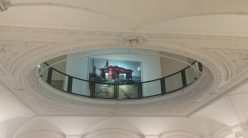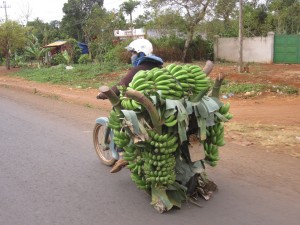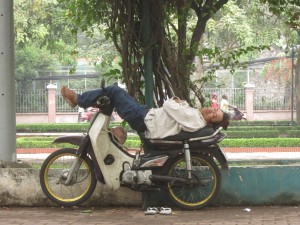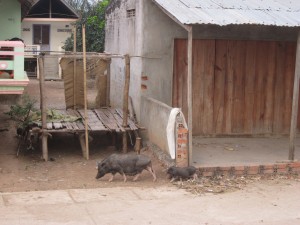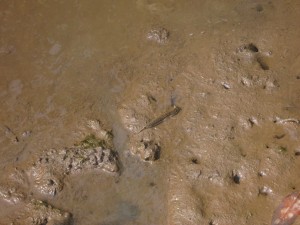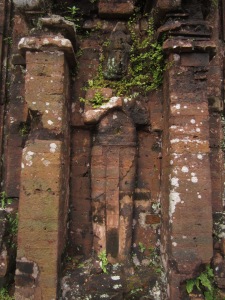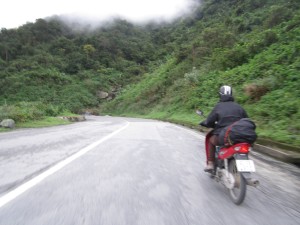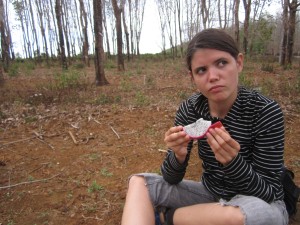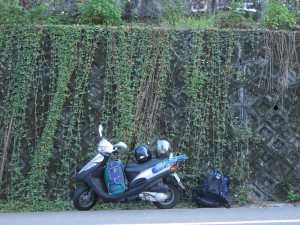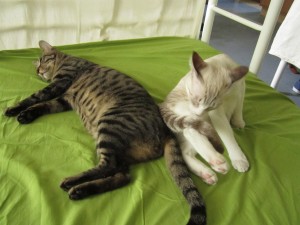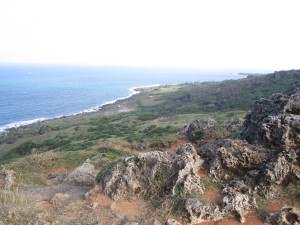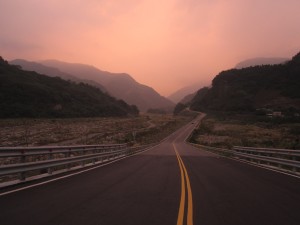Vietnam is definitely the land of “Things on Bikes”. Here is a man driving with over a dozen jackfruit attached to baskets on his scooter. These smelly but tasty fruits are incredibly dense and heavy.
Bananas are another common crop, hence their presence on scooters. The vast majority of people do not own cars, but scooters and/or bicycles. If you wander off of the main roads and into the alleys or deep into the countryside, you’ll find that many of the lanes are so narrow that a car couldn’t possibly fit on them.
Not only produce, but livestock, is carried around on scooters. Here is a man with a selection of chickens fastened to the back of his bike. I’ve also seen ducks, and even pigs, riding as passengers.
People even use their scooters as beds to nap during the hot hours of the day. I have no idea how they are able to maintain such balance.
This was taken from a pagoda in Dalat. Due to its mean facial expression, I think it is supposed to be a guard.
We also stopped by the Valley of Love in Dalat, a perfect place to take cheesy photos. For anyone who is interested, they host a fine selection of plastic big cats.
We traveled to Lak Lake one night to do a homestay in a longhouse. Upon arrival to the cafe that arranges these homestays, we discovered they had an elephant to the side. I think the elephants in this town are only used for tourists to ride into the lake.
In this small town, the animals definitely seem part of the community. Pigs, dogs and chickens graze around between the properties. While nice to look at during the day, they do make it hard to sleep at night, by constantly barking or crowing in the dark.
Many miles later, we made it down to the busy city of Saigon, or Ho Chi Minh City. Being the biggest city of Vietnam, it consequently seemed to hold the highest concentration of traffic. It is normal to find people driving the opposite way down one-way streets, on sidewalks, right into busy traffic, or anywhere a bike may possibly fit. Though it seems chaotic, traffic does go on like it does anywhere else. One just cannot drive the way they do in their home country while riding around in Saigon.

After a few days in this busy, crowded city, we decided to take a nature break and go check out a mangrove forest. This part of the country is the Mekong Delta, so all of the land is separated by small rivers, which requires taking a ferry from one point to another.

Once we got there, we wished we had a boat to go around, rather than a scooter.
Off the long, flat, paved road, we found one of the muddy paths leading into the depths of the mangrove forest. If you head down one of these, make sure you wear some sturdy hiking or rubber boots, as a few inches of mud will stick to your shoes.
We walked down this path until it got too muddy and slippery, and admired the sturdy, intricate roots that these trees stand from.
The wet mud on the ground is full of little holes that tiny crabs crawl into and out of. If you look closely (in the picture or in nature), you can spot a mudskipper. I don’t know if these creatures need to hide from many predators, but they certainly do embody a good camouflage tone for such an environment.
